Series Analysis: Thrilling Indian Peace Medals in Partrick Collection - The Panoramic Partrick Collection, Report #2
Two American Indian Peace Medals from the 18th century were highlights of the special Partrick Platinum Night auction session on April 22. This was part of a large auction extravaganza conducted by Heritage at this firm’s headquarters near the Dallas Fort Worth Airport.
Two American Indian Peace Medals from the 18th century were highlights of the special Partrick Platinum Night auction session on April 22. This was part of a large auction extravaganza conducted by Heritage at this firm’s headquarters near the Dallas Fort Worth Airport.
The most noteworthy result in this Partrick session was the $630,000 paid for a 1793 Indian Peace Medal that depicts George Washington, the first president of the United States. He was earlier the commander-in-chief of American revolutionary forces during the battle for independence from Great Britain.
I had already decided to focus upon this Washington 1793 Indian Peace Medal before I contacted Alan Weinberg, a legendary collector of early American numismatic items. Parts of Alan’s collection were auctioned by Heritage in multiple sessions during 2019 and 2020. Weinberg purchased most of his rarities long ago, during times when market levels were much lower than they have been during the last twenty years. I was surprised to learn that he was the buyer of this medal, for a record price.
Weinberg identified himself as the buyer and agreed to be interviewed. He furnished his own photos of this medal. He says he received this medal on Tuesday, April 27, soon after the Partrick session on Thursday, April 22. Alan was ecstatic.
“To acquire a choice, well engraved, hallmarked by Joseph Richardson, oval George Washington Indian Peace Medal is almost literally a once in a lifetime opportunity. I was determined to acquire it as I’m 77 and will have no future chance,” Weinberg declared.
Alan begin collecting coins in 1958. “I skipped the usual sets of coins and immediately progressed to 1793 Chain and Wreath large cents, buying a choice clean Very Fine 1793 Chain ‘with periods’ cent for $675 in a 1962 Stack’s auction. By 1962, I was acquiring significant choice colonial rarities from Dick Picker and Bill Anton for up to $3,750 [each]. In June 1962, the summer I graduated from high school, Dick Picker phoned to offer me the Virgil Brand Brasher doubloon for $14,000. A few weeks later he again called to offer me the Brand 1786 date under plowbeam New Jersey Copper for $8,000. Unfortunately, I passed on both ultra-rarities not having the money in hand. I should have asked my father if …,” Weinberg now reveals.
Weinberg collected a variety of 18th and 19th century medals, though this is his sole acquisition of a choice Washington administration Indian Peace Medal. These are distinct as they are silver ovals and were directly engraved. Later U.S. Indian Peace Medals were round and were struck from dies rather than being directly engraved.
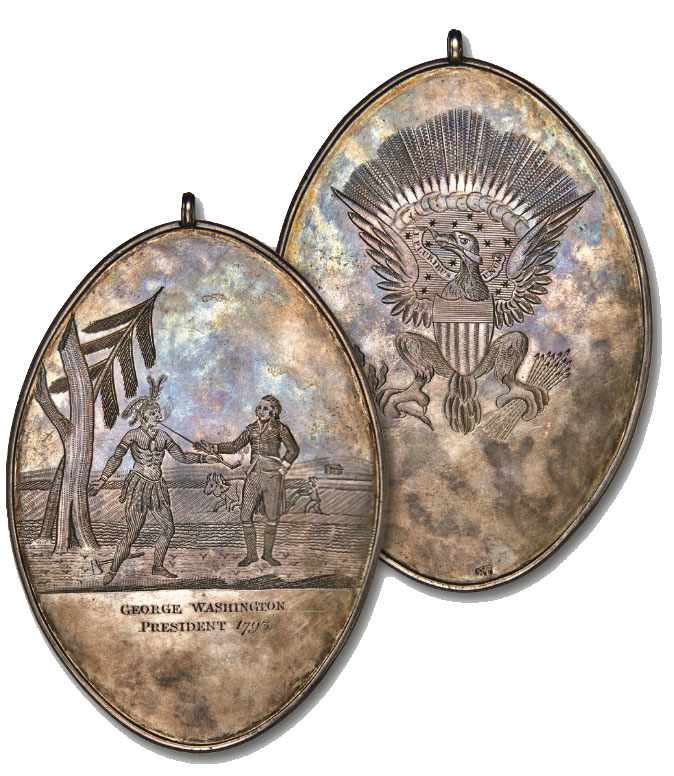
It was customary for the portrait of a U.S. president to appear on the
obverse of official U.S. Indian Peace Medals. In many cases, restrikes of
19th century Indian Peace Medals in silver and/or copper were made at the
Philadelphia Mint for the general public.
Alan Weinberg emphasizes that the Washington administration “1792, 1793 and 1795 oval engraved silver Indian Peace Medals appeal to a broad spectrum of collectors, not just collectors of medals.” This is my understanding as well. They are sought by collectors with varying specialties: Washington, colonial coins, early U.S. coins, products of Early American silversmiths, political artifacts, antiques relating to American Indians, etc.
“The vast majority of [apparently surviving] oval engraved George Washington Indian Peace Medals are in museums or other historic institutions, of which a significant percentage are of questionable authenticity or have been excessively polished causing the engraving to weaken and become mushy. Such institutions believe originally toned, patinated silver is not easily viewed and must be brightened to be visible to the viewers,” Weinberg explains.
Two similar Washington administration Indian Peace Medals were auctioned in the Partrick auction session in January. These realized substantially less than the presently discussed $630,000 medal that sold in April. This 1793 medal is not rarer as a date than the 1792 and 1795 medals that sold in the Partrick session in January. This 1793 is, however, technically more impressive. The technical rating of a coin or medal relates to hairlines, contact marks, consequences of cleanings or dippings, abrasions from handling, additives, etc.
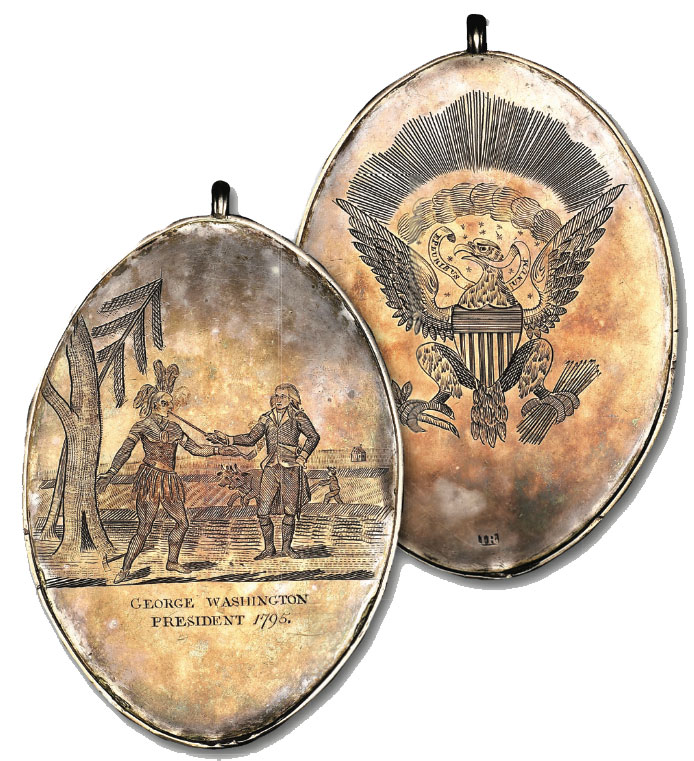
Reportedly, Washington administration Indian Peace Medals dated 1789, 1792,
1793 and 1795 are known. There is a 1789 medal that is pictured in works by
Bauman Belden and there was a 1789 in the Ford II sale by Stack’s (NY) in
May 2004 that was identified as a “modern copy” by the cataloguer.
I am not convinced that a genuine 1789 medal exists, though I am not now prepared to draw a conclusion. Alan Weinberg is suspicious of the 1789 George Washington Indian Peace Medals that have come to his attention, which he believes are not authentic and were likely to have been made much later than 1789.
Bauman Belden’s primary work on Indian Peace Medals was published by the ANS in 1927. This monograph is available on the Newman Numismatic Portal. The stories surrounding the two 1789 medals that Belden mentioned are vague and unconvincing. The 1789 that is pictured in Bauman’s work is much different from and artistically inferior to widely accepted 1792, 1793 and 1795 medals.
One reason why it is difficult to authenticate Washington administration Indian Peace Medals is that a very small number, one to four, were known to leading numismatists in the 19th century. Landmark references regarding medals by Loubat (1878) and Baker (1885) each cite just one Washington administration Indian Peace Medal, the same 1792 medal, which was given to “Red Jacket.” Reportedly, that 1792 medal is now in a historical society in upstate New York.
The absence of Washington administration Indian Peace Medals from the McCoy and Mickley Collections is relevant. In 1864, the first epic collection of U.S. coins to be publicly sold was that of John McCoy, which was handled by the firm of W. E. Woodward and auctioned in New York over a period of five days. McCoy had Indian Peace Medals from the administrations of Thomas Jefferson, James Madison, James Monroe and later presidents, yet not one depicting George Washington.
The Mickley sale of 1867 included numerous Indian Peace Medals relating to
multiple presidents, though none featuring George Washington. Moreover,
Joseph Mickley had a large group of Washington related numismatic items,
including medals, tokens and patterns. If he could have acquired a
Washington administration Indian Peace Medal, he probably would have done
so. Mickley had been aggressively collecting coins and medals for many
years.
The collection of Charles Bushnell is famous for an incredible selection of medals, yet there was not a Washington Administration Indian Peace Medal in the auction of Bushnell’s American numismatic items by the Chapman brothers firm in 1882. The epic Parmelee (1890) and Stickney (1907) sales also lacked a Washington administration Indian Peace Medal.
Several leading collectors during the late 19th century sought Indian Peace Medals and they were not avoiding oval shaped medals in general. While coin collectors now tend to think of medals as being round, many prominent coin collectors then had oval shaped medals of some sort in their respective collections. Evidently, the leading collectors U.S. coins and medals during the late 19th century were unable to acquire Washington administration Indian Peace Medals.
The Garrett-Partrick 1795 medal that sold in January 2021, as lot #3966 for $288,000, was earlier in the sale of the Charles Morris Collection by the Chapman brothers in April 1905. The $630,000 Partrick-Brand-Weinberg 1793 medal was earlier in the sale of the William Hunter Collection by the firm of S. H. Chapman in December 1920, lot #90. Pedigrees were noted in the Heritage auction catalogue.
I found a PDF copy of the Hunter Collection catalogue on the Internet. Lot #90 is indeed the same as the Partrick-Brand-Weinberg medal. It brought $550 in 1920. In June 1984, this same medal realized $37,400 in a sale by Bowers & Merena of items that were earlier part of Virgil Brand’s collection. This medal was then said to be “Extremely Fine or better.” In my view, a Choice Extremely Fine grade is fair.
There was also 1795 ‘middle size’ Washington Indian Peace Medal in the Hunter Collection sale of December 1920, which is similar to the Garrett-Partrick medal that brought $288,000 in January 2021, though is a different medal. The Hunter Collection 1795 realized $800, an astronomical price for a medal in 1920.
A substantial percentage of the items in the Hunter sale in 1920 realized less than $2 each. More than fifty items brought less than fifty cents each, and several realized two cents each. Lot 717, a twenty piece lot of religious medalets, realized merely one cent.
While the Hunter Collection 1793 is clearly genuine and I have no reason to question the authenticity of the Hunter Collection 1795, there were then and are now replicas and forgeries around of multiple dates of Washington administration Indian Peace Medals. I have been informed that Partrick himself owned at least a couple of replicas or forgeries of Indian Peace Medals. I saw one that I had doubts about.
Alan Weinberg asserts that a large percentage of “oval George Washington Indian Peace Medals on the market are bogus. Some are deceptive, having emanated in the 1960s from Ohio. But the unique structure of genuine ovals, beyond just the skilled engraving, fortunately enables knowledgeable collectors to discern the genuine from the fake.”
According to researcher George Fuld, the Partrick Collection 1792 medal that sold in January is one of just six that are not in museums, including all sizes of 1792 Washington administration Indian Peace Medals. That Partrick 1792 medal was earlier in the John Ford Collection, and was auctioned by Stack’s (NY) in May 2004. The Ford-Partrick 1792 was catalogued as “Choice Very Fine.” In 2021, it was accompanied by an NGC photo certificate that states that it is genuine. I find it to be gradable. Most 18th century coins and medals have hairlines, contact marks and/or other technical issues. A Very Fine grade is fair.
In January, the Ford-Partrick 1792 medal realized $264,000. In May 2004, it realized $276,000. Alan Weinberg recollects that he was the underbidder in 2004. In 2021, Weinberg decided to focus upon the Partrick-Brand 1793 rather than the Ford-Partrick 1792, mostly because of the superior surface quality of the Partrick-Brand 1793.
I like the Ford-Partrick 1792 more than Weinberg does. While there are gray, brownish and very dark areas, these are not unusual on relatively original silver items from the 18th century. It scores relatively high in the category of originality, and is exemplary for an 18th century medal. Natural orange-russet, pale russet and blue colors are attractive. Although the Partrick-Brand-Hunter-Weinberg 1793 is technically more impressive than the Ford-Partrick 1792, they are both attractive, naturally toned and gradable.
The Garrett-Partrick Collection 1795 medal that sold in January had neat and colorful, natural toning, really an item that should be seen in actuality. This medal has some hairlines and other technical issues, though no one is expecting issued Indian Peace Medals to be like gem quality coins. It brought $288,000 in January 2021. This is one of five known and one of three 1795 Washington administration Indian Peace Medals that are not in museums.
Current rarity estimates stem from research by George Fuld. Such estimates were published or repeated in various works over a period of many years, including recent Heritage auction catalogues.
In the Garrett IV sale by Bowers & Ruddy in March 1981, the Garrett-Partrick 1795 medal realized $65,000. Many U.S. and colonial coins in the Garrett sales are now worth multiples of the prices realized during the period from 1979 to 1981.
In the Chapman brothers auction of the Charles Morris Collection in 1905, this same Garrett-Partrick 1795 medal realized $300. In that auction in 1905, a 1794 half dollar, which was said to grade “Very Good,” realized $5.50. A coin that was then catalogued as “Very Good,” might grade anywhere from VG8 to VF20 today. Recent Greysheet Bids for 1794 halves in VG8 to VF20 range from $3,500 to $8,600. In this Morris sale, an 1801 half dollar in “Good” realized $2.10 and another 1801 half dollar in “Very Good” reached $2.50. Current Greysheet bids are $800 in G4, $1,300 in VG8, $1,850 in F12, $2,200 in VF20, $4,300 in XF40. I refer to prices realized in the epic Stickney sale of 1907 in my recent article on Brasher Doubloons in the Partrick Collection.
[https://www.greysheet.com/news/story/why-are-partrick-collection-brasher-doubloons-worth-so-much]
This Washington 1793 Indian Peace Medal overshadowed a pre-U.S. Indian Peace Medal in this same Partrick session. Medals were struck for Indian officials who participated in the negotiations that lead to the Treaty of Easton (Pennsylvania) in 1758, an agreement between British-American colonial leaders and chiefs of thirteen Indian nations. This treaty was the culmination of a project started by the Friendly Association for Regaining and Preserving Peace with the Indians by Pacific Means , a Quaker group in the Philadelphia area. It is believed that this group commissioned Edward Duffield to engrave dies.

A member of this Quaker society, Joseph Richardson, was a prominent
silversmith in Philadelphia. He is generally credited with striking the
Treaty of Easton Indian Peace Medals and the earlier Kittaning medals.
Later, he produced Washington administration Indian Peace Medals.
The Treaty of Easton Indian Peace Medals are dated 1757. Joseph Richardson’s son, who was also named Joseph Richardson, inherited the dies, possibly made some restrikes on his own, and later provided the dies to the U.S. Mint, where he was employed. During the 19th century, many restrikes were produced at the Philadelphia Mint.
The Philadelphia Mint restrikes generally have plain edges. The originals were all struck over Eight Reales silver coins of the Spanish Empire.
Partrick’s Treaty of Easton 1757 Indian Peace Medal was earlier in the John Ford Collection. On October 17, 2006, it was auctioned by Stack’s (NY) for $92,000. The Stack’s cataloguer said that thirteen originals are known. On April 22, 2021, this medal realized $168,000.
I found this medal to be much more appealing than I thought I would. Indisputably, it is uncirculated. The purple-gray, russet-gray and green tones are really neat. While there are some light scratches and other technical issues, the eye appeal of this medal is especially memorable. Before the auction, I figured that the obverse had the level of eye appeal that I would associate with a 64 grade and the reverse had the eye appeal of a 63+ grade. While this medal’s technical rating is well below 64, the overall NGC grade of 62 is logical, though I later figured its grade a 62+.
In an auction lot viewing room at Heritage the day after the Partrick
session, the buyer of this medal showed it to the people there. It was raw!
He had arranged for the Partrick-Ford Treaty of Easton Indian Peace Medal
to be cracked out of its NGC holder. When tilted appropriately under a
lamp, this medal became much more vibrant. The purplish-gray and green hues
were enchanting. I wonder how many other uncirculated early American coins
and medals are livelier and more vibrant when examined without holders?
Copyright ©2021 Greg Reynolds
Insightful10@gmail.com
Images courtesy of Heritage Auctions (HA.com) & NGC (NGCcoin.com)

Download the Greysheet app for access to pricing, news, events and your subscriptions.
Subscribe Now.

Subscribe to The Greysheet for the industry's most respected pricing and to read more articles just like this.
Source: Greg Reynolds
Related Stories (powered by Greysheet News)
View all news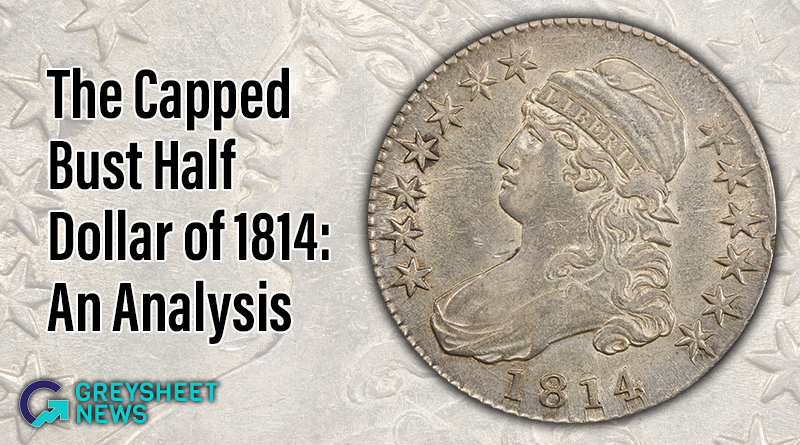
In this article Greg Reynolds analyzes the 1814 Capped Bust Half Dollar.
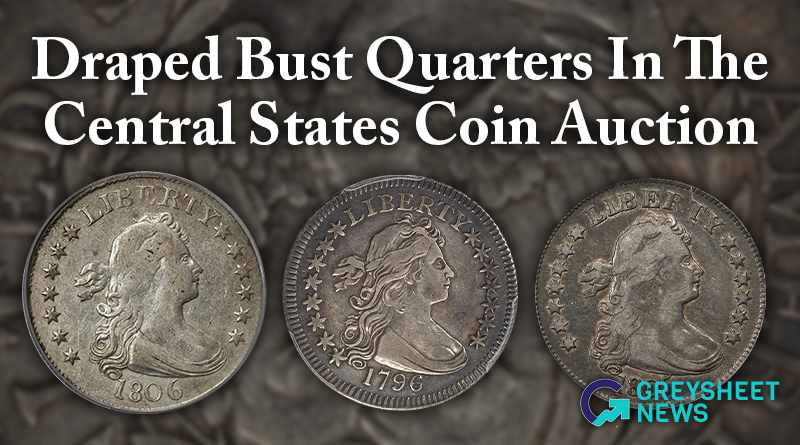
The Lusk set of Draped Bust quarters brought strong results.
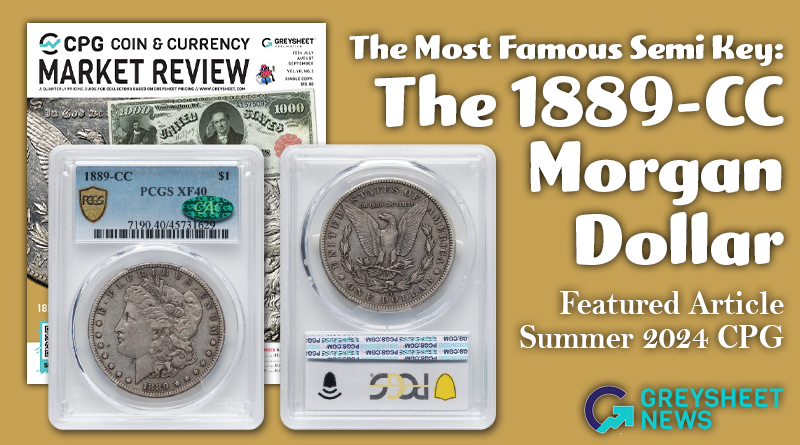
The 1889-CC is the second scarcest business strike in the series.


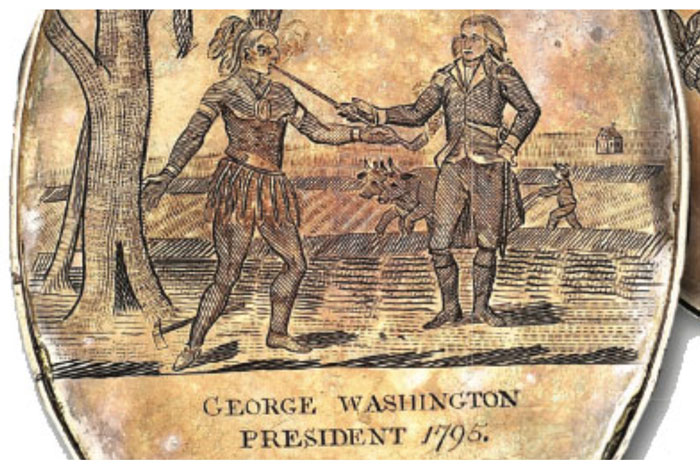






Please sign in or register to leave a comment.
Your identity will be restricted to first name/last initial, or a user ID you create.
Comment
Comments